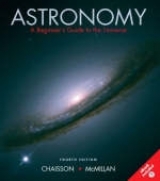
Astronomy
Pearson (Verlag)
978-0-13-087307-1 (ISBN)
- Titel erscheint in neuer Auflage
- Artikel merken
For introductory astronomy courses.
A brief introductory astronomy text designed for students with little or no scientific background. It incorporates the hallmarks of the popular Chaisson/McMillan texts: an exceptionally clear writing style, an emphasis on critical thinking and visualization, and a leading-edge technology program. A free electronic multimedia version of the text is included with each copy.
ERIC CHAISSON holds a doctorate in Astrophysics from Harvard University, where he spent ten years on the faculty of Arts and Sciences. For five years, Eric was a Senior Scientist and Director of Educational Programs at the Space Telescope Science Institute and Adjunct Professor of Physics at Johns Hopkins University. He joined Tufts University, where he is now Professor Physics, Professor of Education, and Director of the Wright Center for Innovative Science Education. He has written nine books on astronomy, which have received such literary awards as the Phi Beta Kappa Prize, two American Institute of Physics Awards, and Harvard's Smith Prize for Literary Merit. He has published more than 100 scientific papers in professional journals, and has also received Harvard's Bok Prize for original contributions to astrophysics. STEVE MCMILLAN holds a bachelor's and master's degree in Mathematics from Cambridge University and a doctorate in Astronomy from Harvard University. He held post-doctoral positions at the University of Illinois and Northwestern University, where he continued his research in theoretical astrophysics, star clusters, and numerical modeling. Steve is currently Distinguished Professor of Physics at Drexel University and a frequent visiting researcher at Princeton's Institute for Advanced Study and the University of Tokyo. He has published over 50 scientific papers in professional journals.
(NOTE: Each chapter concludes with Chapter Review.)I. ASTRONOMY AND THE UNIVERSE.
Prologue: Charting the Heavens.
Our Place in Space. The “Obvious View.” Earth's Orbital Motion. The Motion of the Moon. The Measurement of Distance.
1. The Copernican Revolution: The Birth of Modern Science.
The Motions of the Planets. The Birth of Modern Astronomy. The Laws of Planetary Motion. Newton's Laws.
2. Light and Matter: The Inner Workings of the Cosmos.
Information from the Skies. Waves in What? The Electromagnetic Spectrum. The Distribution of Radiation. Spectral Lines. The Formation of Spectral Lines.
3. Telescopes: The Tools of Astronomy.
Optical Telescopes. Telescope Size. High-Resolution Astronomy. Radio Astronomy. Other Astronomies.
II. OUR PLANETARY SYSTEM.
4. The Solar System: Interplanetary Matter and the Birth of the Planets.
An Inventory of the Solar System. Solar System Debris. The Formation of the Solar System.
5. Earth and Its Moon: Our Cosmic Backyard.
Earth and the Moon in Bulk. The Tides. Atmospheres. Interiors. Surface Activity on Earth. The Surface of the Moon. Magnetospheres. History of the Earth-Moon System.
6. The Terrestrial Planets: A Study in Contrasts.
Orbital and Physical Properties. Rotation Rates. Atmospheres. The Surface of Mercury. The Surface of Venus. The Surface of Mars. Internal Structure and Geological History. Atmospheric Evolution on Earth, Venus, and Mars. The Moons of Mars.
7. The Jovian Planets: Giants of the Solar System.
Observations of Jupiter and Saturn. The Discoveries of Uranus and Neptune. The Jovian Planets in Bulk. Jupiter's Atmosphere. The Atmosphere of the Outer Jovian Worlds. Jovian Interiors.
8. Moon, Rings, and Pluto: Small Worlds among Giants.
The Galilean Moons of Jupiter. The Large Moons of Saturn and Neptune. The Medium-Sized Jovian Moons. Planetary Rings. Pluto and Its Moon.
III. STARS AND STELLAR EVOLUTION.
9. The Sun: Our Planet Star.
The Sun in Bulk. The Solar Interior. The Solar Atmosphere. The Active Sun. The Heart of the Sun.
10. Measuring the Stars: Giants, Dwarfs, and the Main Sequence.
The Solar Neighborhood. Luminosity and Apparent Brightness. Stellar Temperatures. Stellar Sizes. The Hertzsprung-Russell Diagram. Stellar Masses. Extending the Cosmic Distance Scale.
11. The Interstellar Medium: Birthplace of Stars.
Interstellar Matter. Interstellar Clouds. The Formation of Stars Like the Sun. Stars of Other Masses. Star Clusters.
12. Stellar Evolution: The Lives and Deaths of Stars.
Leaving the Main Sequence. Evolution of a Sun-Like Star. The Death of a Low-Mass Star. Evolution of High-Mass Stars. Supernova Explosions. Observing Stellar Evolution in Star Clusters.
13. Neutron Stars and Black Holes: Strange States of Matter.
Neutron Stars. Pulsars. Neutron-Star Binaries. Black Holes. Black Holes and Curved Spaces. Space Travel near Black Holes. Observational Evidence for Black Holes.
IV. GALAXIES AND COSMOLOGY.
14. The Milky Way Galaxy: A Grand Design.
Our Parent Galaxy. Measuring the Milky Way. Large-Scale Structure. The Galactic Spiral Arms. The Mass of the Milky Way. The Galactic Center.
15. Normal Galaxies: The Large-Scale Structure of the Universe.
Hubble's Galaxy Classification. The Distribution of Galaxies in Space. Galaxy Masses. Galaxy Formation and Evolution. Hubble's Law.
16. Active Galaxies and Quasars: Limits of the Observable Universe.
Beyond the Local Realm. Seyfert Galaxies. Radio Galaxies. The Central Engine of an Active Galaxy. Quasi-Stellar Objects. Active Galaxy Evolution.
17. Cosmology: The Big Bang and the Fate of the Universe.
The Universe on the Largest Scales. Cosmic Expansion. The Fate of the Universe. The Geometry of Space. Back to the Big Bang. The Formation of Nuclei and Atoms. Cosmic Inflation. The Formation of Large-Scale Structure in the Universe.
18. Life in the Universe: Are We Alone?
Cosmic Evolution. Life in the Solar System. Intelligent Life in the Galaxy. The Search for Extraterrestrial Intelligence.
Appendices.
Scientific Notation. Astronomical Measurement. Tables.
Glossary.
Answers to Concept Check Questions.
Answers to Self-Test Questions.
Index.
Star Charts.
| Erscheint lt. Verlag | 25.1.2001 |
|---|---|
| Sprache | englisch |
| Maße | 276 x 279 mm |
| Gewicht | 1152 g |
| Themenwelt | Sachbuch/Ratgeber ► Natur / Technik ► Weltraum / Astronomie |
| ISBN-10 | 0-13-087307-1 / 0130873071 |
| ISBN-13 | 978-0-13-087307-1 / 9780130873071 |
| Zustand | Neuware |
| Haben Sie eine Frage zum Produkt? |
aus dem Bereich



